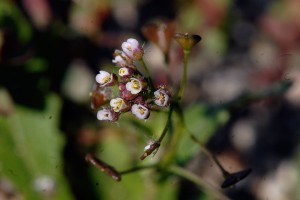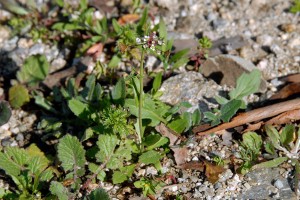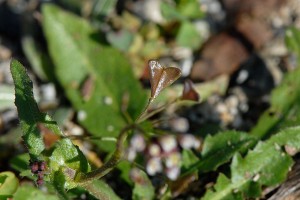…on finding a root of shepherd’s purse (Capsella bursa-pastoris) open a seed-vessel. If the seed is yellow you will be rich, but if green you will be poor.
Yorkshire Folklore
BFS Manager Stephen Dreher has spotted a new addition for the BFS Plant List: Shepherd’s Purse (Capsella bursa-pastoris). Shepherd’s Purse, which originated in the Middle East, tends to grow in disturbed ground and spread widely with the rise of agriculture. It’s now found on all continents and appears to thrive everywhere except the humid tropics.
Capsella bursa-pastoris is a member of the Brassicaceae (Mustard Family), and has a basal rosette of leaves from which a flowering stalk emerges. The stalk can be up to the 2 ft, but the plants seen at the BFS are only a few inches tall. Capsella bursa-pastoris has been used as model organism particularly for evolution of floral development, where it can be compared to its close relative Arabidopsis thaliana.
Like other mustards, Shepherd’s Purse is edible, and the leaves are reported to be milder than other mustards. Shepherd’s Purse has been used in traditional medicine to control bleeding, but no studies of this use are reported in the scientific literature. The plant is named ‘Shepherd’s Purse’ because the heart-shaped seed pods are supposed to resemble purses once carried by shepherds.
References:
- Hintz, M., C. Bartholmes, P. Nutt, J. Ziermann, S. Hameister, B. Neuffer, and G. Theissen. 2006. Catching a ‘hopeful monster’: shepherd’s purse (Capsella bursa-pastoris) as a model system to study the evolution of flower development. J. Exp. Bot. 57: 3531-3542. http://jxb.oxfordjournals.org/cgi/content/full/57/13/3531
- Ceplitis A., Y. Su, and M. Lascoux. 2005. Bayesian inference of evolutionary history from chloroplast microsatellites in the cosmopolitan weed Capsella bursa-pastoris (Brassicaceae). Mol. Ecol. 14: 4221-4233. http://www3.interscience.wiley.com/journal/118705992/abstract
- DeFelice, M.S. 2001. Shepherd’s-purse, Capsella bursa-pastoris (L.) Medic. Weed Technol. 15: 892-895. http://www.bioone.org/doi/full/10.1614/0890-037X(2001)015[0892:SSPCBP]2.0.CO;2


